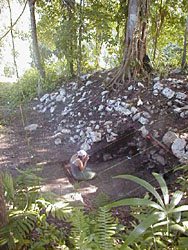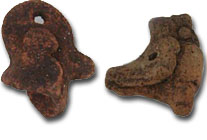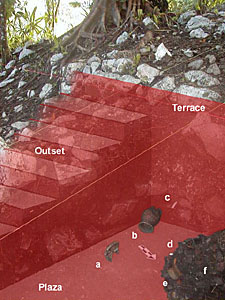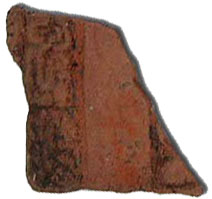

| |
| Pook's Hill: The Western Structure |
"Maya Caves of West-Central Belize" Summer 2000 |
| by Christophe Helmke | |
 Structure 2A as seen from the summit of Structure 1 looking south. The excavation unit shows the facing of the outset staircase (to the left) and the terrace facing (to the right). |
Despite the continued investigations in front of the eastern shrine (Structure 4A), the investigations carried out this summer were focused on the western structure of the plazuela. Western structures in plazuela groups typically serve residential functions. Numerous anomalous cases from plazuela groups at Tikal, however, suggest that western structures can be the most variable in function. In certain cases they appear to have served as shrines, in other as reception halls for visiting dignitaries or officials.
We decided to strip the architectural collapse and overburden off the terminal phase architecture of Pook's Hill's western structure (Structure 2A), hoping to reveal the function this structure may have served. In a thorough and detailed analysis of ceramic function the context in which these were used also needs to be taken into account. Hence the need to determine the function of the Western structure prior to determining that of the ceramics associated with its use. Based on the 1999 excavations, we know that Pook's Hill was abandoned shortly after the peak of cave usage in the Roaring Creek Valley. In order to recover comparative materials from surface sites that are contemporaneous with the materials from the caves, we determined that the Western structure would not have to be penetrated by excavation. Instead, all that needed to be done was to strip the collapse off the last phase of architecture and hope to find artifacts and ceramic materials suggestive of the building's use during the peak period of cave use. As theory rarely translates into a reality, it is amazing that the Western structure excavation yielded far more than we hoped for.
Architectural Collapse

Clearing the architectural collapse of Structure 2A
It took us nearly three complete weeks to clear all of the collapsed architecture and overburden off one-third of the western structure. Part of the reason for this was the apparently poor preservation of the structure's summit and the large quantity of artifacts encountered in the collapse.
Just to offer an idea of the quantity of artifact types represented: ceramic sherds were found throughout, fragmentary vessels, Belize Molded-carved sherds, as were large quantities of animal remains, isolated human teeth and bone fragments, lithic debitage, obsidian blades, exhausted obsidian cores, fragmentary metates (grinding stones), complete and fragmentary ocarinas (small effigy ceramic whistles), a ceramic figurine fragment, complete and fragmentary formal stone tools, a spherical grooved groundstone, and a tubular bead with a drill hole for suspension. Right, ocarinas (whistles), one complete and still functional, and a figurine fragment from the collapse of Structure 2A |
  |
The quantity of the material is impressive and suggests that the structure collapsed shortly before or after its abandonment as few of the artifacts show signs of weathering or exposure to the elements. The artifacts also suggest that little was cleaned up or swept away as everything was found mixed in the same architectural collapse. All the ceramics date either to the end of the Late Classic (A.D. 800-900) or the beginning of the Early Postclassic (A.D. 900-1000). The consistency of the ceramic types and their restriction to a particular time period suggests that the artifacts uncovered from the collapse represent part of the last phase of the western building's usage.
Midden
 The top of the midden as cleared, seen from the top of Structure 2A. Level area to the right of the midden is the plastered plaza floor. |
One of the most cherished discoveries in archaeology is someone's garbage dump, one of the most revealing contexts as it represents the discarded remains of everyday life. In clearing off the plastered plaza floor in front of the western structure, we encountered the remains of a midden, the term used in archaeology for a pile of refuse. Typically the Maya discarded their refuse by going to the edge of a building and dumping behind it or off the side of a platform. Instead the midden at Pook's Hill was deposited directly on the plaza floor in the patio's corner where Structure 2A and Structure 1 meet (see figure below). This indiscriminate garbage dump in full view suggests that sanitary concerns of the plazuela's inhabitants during the last phase of occupation were at a minimum. The presence and placement of the midden paints a relatively dreary picture of the last months or years of the plazuela's occupation.
 Computer-assisted reconstruction drawing showing the western side of the plazuela and the northern structure of the group. (Christophe Helmke) |
 |
The two principal artifactual components of the midden are ceramic sherds and animal remains. Most of the ceramic sherds are those of serving vessels or drinking vases. The most common animal remains found in the midden are the shells of freshwater snails (called jute in Spanish, or tutu in Yucatec Maya). Jute are typically boiled in a spicy soup that is still eaten today. So as to consume the edible insides, the tips of the shell are broken off and the contents sucked out. The majority of the shells in the midden have their tips broken off, indicating that they are the leftovers of meals. This coupled with the fact that the majority of the ceramics are serving vessels and drinking cups indicates that the midden is comprised of the remains of meals. Left, close-up of the midden showing fragmentary ceramic serving vessels and many jute shells |
Terminal Occupation Debris Once the collapse was removed from the plaza floor and the midden exposed, we began clearing along the base of the western structure's outset staircase and the terrace facing. At the base we found two concentrations of artifacts, a nearly complete metate, and a complete vase. It would appear that the collapse of the building atop the western platform (Structure 2A) was very rapid thereby sealing all the artifacts that were piled on the plaza floor, along the base of the terrace, including the midden, in situ. As none of the artifacts display any erosion due to exposure to the elements, it seems that the building collapsed before the site was completely abandoned. Thus all artifacts recovered along the base of the terrace date to the terminal phase of occupation, and all may relate to the use and function of the western structure. |
 Terminal occupation debris as cleared. Note the facing of the outset staircase to the left. The row of stones running along the top of the picture is part of the slumped facing of the terrace. The complete vase is in the corner, and the concentration of ceramic sherds and the granite metate lean against the wall. |
 |
Clarification of the architecture so as to emphasize the placement and distribution of terminal occupation debris a: Alexanders Unslipped rim (storage jar) b: Non-Fine Orange Pabellon Molded-carved vase (drinking vessel) c: Ocarina (ceramic whistle) d: Spire-lopped, perforated olivella shell (tinkler) e: Early Postclassic censer f: Concentration of artifacts (miniature midden) |
Function of Structure 2A?
What can we say of the western structure's usage? We know that meals were consumed there based on the presence of the midden, and we know that food may have been processed in or near Structure 2A based on the presence of several metate fragments. We know, based on the presence of at least six ocarinas, that they were playing music. Based on the olivella shell tinklers and the tubular bead, Structure 2A may have been a building in which people felt the need to wear regalia, jewelry, or both. The complete vessel is a type of vase that appears to have been used for the consumption of special beverages such as a frothy cacao or atole (corn gruel). Taken as a whole it would seem that the western structure may have been the setting of banquet-type meals that were accompanied by the playing of music.
This scenario brings to mind the function of a specific type of building known in the ethnohistoric literature as a popol na (i.e. "mat house" in Yucatec). The popol na is "the name by which were known municipal buildings in colonial times, of which was in charge the ah hol pop (i.e. "the one at the head of the mat"); where they assembled to discuss public affairs and learn to dance for the town festivals." In addition ah hol pop is glossed as: "head of the banquet, stewart of the house called popol na [...]"
The last piece of evidence are the sherds of Belize Molded-carved vases. The hieroglyphic caption that accompanies them includes one glyph that refers to the vases themselves. Although it is a difficult glyph to read, it may read as "gift-giving" indicating that the vessels were made as gift-giving vessels to be exchanged at banquets. The exchange of vases at feasts is well documented in the ethnohistorical literature. |
 Sherd of Belize Molded-carved vase found in the collapse of Structure 2A |
Although it is suggested that the western structure of Pook's Hill may have served some of the functions of a popol na, we are by no means suggesting that the site was the seat of any government. Instead we are suggesting that specialized feasting halls were present in plazuela groups, as settings for feasting and other formal meetings.
Advertisement

Advertisement






